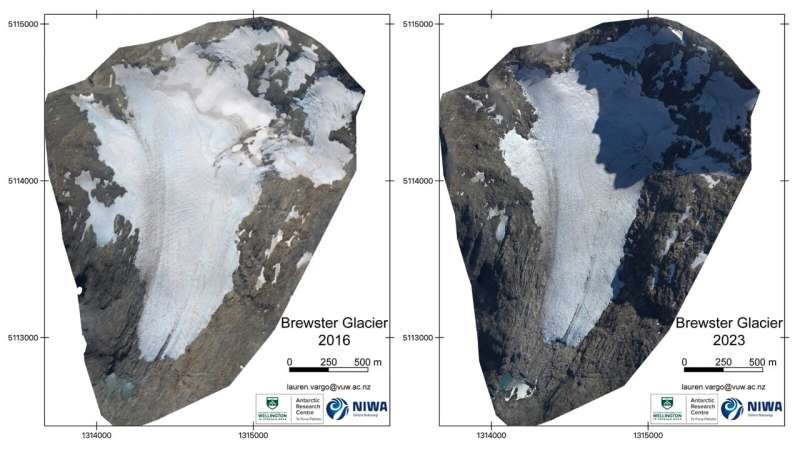This article has been reviewed according to Science X's editorial process and policies. Editors have highlighted the following attributes while ensuring the content's credibility:
fact-checked
trusted source
proofread
Further loss for Aotearoa's glaciers

Researchers from Te Herenga Waka—Victoria University of Wellington have shown continued loss of ice and snow in NIWA's annual end-of-summer survey. The 2023 survey was the 46th undertaken in a collaboration between the University, NIWA, and the Department of Conservation Te Papa Atawhai. The long-standing project captures an aerial portrait of more than 50 Southern Alps glaciers at a similar time each year to track how they change.
Dr. Lauren Vargo, a research fellow in the Antarctic Research Center at the University, says it's the eighth year in a row that the glaciers have been noticeably smaller.
"My first year on the snowline flight was 2016, and since then I've watched Aotearoa's glaciers lose mass almost every year. There was a record melt in 2018, and nearly the same amount in 2019—it's sad to see."
The team spent nearly eight hours traveling back and forth across the Southern Alps. They took thousands of aerial photographs of glaciers to use in various national and international research projects.
"We have a GPS in the plane that tells us precisely where the photos are being taken from," Lauren says. "Using these photos and locations, we create 3D models of the glaciers each year. These make it easy to measure changes in glacier length and area, and compare the models year to year to measure changes in ice volume."
NIWA Principal Scientist Dr. Andrew Lorrey, who coordinates the survey, says this year's observations do not suggest a reprieve or a reversal of the ongoing ice loss trend any time soon.
"We've already had to abandon some of the index glaciers that we used to monitor because their snowlines and meaningful ice volume have completely disappeared."
Dr. Vargo says the ice loss is very worrisome for New Zealand.
"Our glaciers are important, both as taonga and as a water resource—particularly for agriculture in spring and summer as the melt provides irrigation to the surrounding areas."
She says on top of this immediate concern, this year's result is a confronting consequence of climate change more generally.
"The glaciers are showing us that temperatures are continuing to warm, and the subsequent impacts from that, such as sea level rise and extreme weather events, are going to affect so many people in New Zealand and around the world.
"The glaciers are the canary in the coal mine, and we can't afford to ignore them."
Associate Professor Brian Anderson, also at the Antarctic Research Center, says that the rate of ice loss in the last few years has been surprisingly high.
"Over the last 20 years we have used glacier measurements, including from the snowline flights, to develop models of glacier behavior. This work has shown that we will continue to lose ice until at least 2050 due to climate warming, but after that the trajectory really depends on our greenhouse gas emissions.
"If we can make rapid and deep cuts to fossil fuel use, many of our glaciers can be saved—albeit at a much smaller size."
Provided by Victoria University of Wellington



















